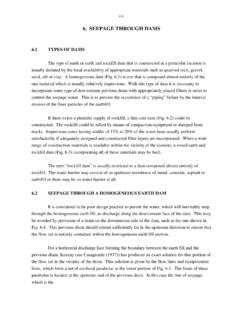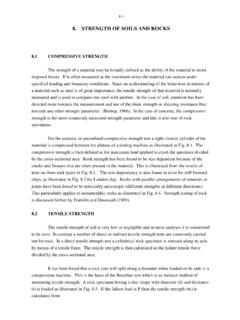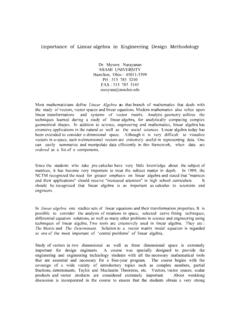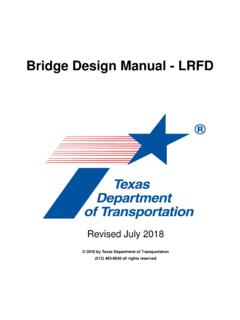Transcription of 13. AN INTRODUCTION TO FOUNDATION ENGINEERING
1 13-1 13. AN INTRODUCTION TO FOUNDATION ENGINEERING TYPES OF FOUNDATIONS The FOUNDATION is that portion of a structure that transmits the loads from the structure to the underlying FOUNDATION material. There are two major requirements to be satisfied in the design of foundations: (a) Provision of an adequate factor of safety against failure of the FOUNDATION material. Failure of the FOUNDATION material may lead to failure of the FOUNDATION and may also lead to failure of the entire structure. (b) Adequate provision against damage to the structure which may be caused by total or differential settlements of the foundations.
2 In order to satisfy these requirements it is necessary to carry out a thorough exploration of the FOUNDATION materials together with an investigation of the properties of these materials by means of laboratory or field testing. Using these physical properties of the FOUNDATION materials the foundations may be designed to carry the loads from the structure with an adequate margin of safety. In doing this, much use may be made of soil mechanics but to a large extent FOUNDATION ENGINEERING still remains an art. This chapter will be largely concerned with the contributions that may be made by soil mechanics to FOUNDATION ENGINEERING .
3 There are four major types of foundations which are used to transmit the loads from the structure to the underlying material. These foundations types are illustrated in Fig. The most common type of FOUNDATION is the footing which consists of an enlargement of the base of a column or wall so that the pressure transmitted to the FOUNDATION material will not cause failure or excessive settlement. In order to reduce the bearing pressure transmitted to the FOUNDATION material the area of the footing may be increased. As the size of the footing increases however, the deeper the effect of footing pressure extends as was illustrated in Geomechanics 1.
4 If the FOUNDATION material cannot withstand the pressure transmitted by the footings the pressure may be reduced by combining all of the footings into a single slab or raft covering the entire plan area of the structure as illustrated in Fig. Raft foundations are also used to bridge localised weak or compressible areas in the FOUNDATION material. They are also used where it is desirable to reduce the differential settlements that may occur between adjacent columns. 13-2 FIGURE FOUNDATION TYPES 13-3 At a building site, firm FOUNDATION material may be overlain by strata of weak or compressible soil.
5 In this case a pile FOUNDATION may be a satisfactory solution to transmit the structural loads through the weak material to the firmer underlying material. The piles may be driven steel, concrete or timber sections or may be made of cast in place concrete. These foundations are often classified either as end (or point) bearing piles or friction piles depending upon the major source of the support. Piers are sometimes used for the transmission of large loads to firm FOUNDATION material which may be overlain by poorer material. Piers may be considered generally as large diameter cast in place piles.
6 Piers are sometimes constructed as caissons in which the FOUNDATION members are sunk through the soil. With open caissons the hole is advanced by means of internal dredging and in the case of pneumatic caissons excavation is carried out under compressed air to prevent the entry of water and mud into the working chamber. SETTLEMENT ANALYSES Foundations of structures may experience movements through a number of causes, among which may be listed: (a) elastic and inelastic compression of the sub-soil due to the weight of the structure, (b) ground water lowering, producing an increase in effective stress beneath the FOUNDATION , (c) vibration due to pile driving, machinery vibrations etc.
7 Which is of particular importance in granular soils, (d) seasonal swelling and shrinking of expansive clays, (e) adjacent excavation and construction which may cause movement of the foundations, (f) regional subsidence or movement. This section will be concerned mainly with settlement which is caused by changes in load such as the weight of a building. For conditions of one dimensional compression the calculation of the amount of settlement and the rate at which it occurs have been covered in Geomechanics 1. This technique, which is based upon the results of oedometer tests will be referred to as the conventional method in the following discussion.
8 Unfortunately, in FOUNDATION ENGINEERING practice, one dimensional compression conditions are not frequently encountered and consequently the use of the conventional method for the calculation of the amount and rate of settlement may not be reliable. This is illustrated in Figs. and which show comparisons between calculated and observed settlements for the Waterloo bridge , London, and the Monadnock Block, Chicago. In 13-4 these two instances both the amount and rate of settlement calculated by means of a conventional method considerably underestimate the values observed.
9 In calculating the rate of settlement of a structure it is necessary to determine the boundary conditions in relation to drainage, then to use the appropriate theoretical solution that satisfies the actual boundary conditions. Regarding the calculation of the amount of settlement it is widely observed, as illustrated in Figs. and , that a settlement occurs during the period of construction which is not predicted by the conventional one dimensional method. This type of observation has led to the two components of settlement being considered separately.
10 The first component is an immediate settlement which occurs immediately following the application of load and the second component is a consolidation settlement which occurs as the pore pressure dissipates. The stress changes which take place in the soil as the immediate and consolidation settlements occur are quite different from those when settlement takes place under one dimensional conditions only. The stress path followed by a sample of soil undergoing one dimensional consolidation is illustrated in Fig. The stress paths that are drawn in this figure are for a representative element of soil beneath a FOUNDATION and beneath the water table.














